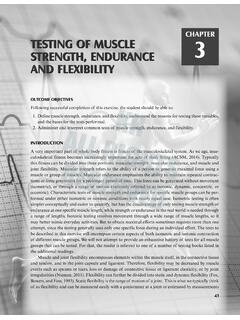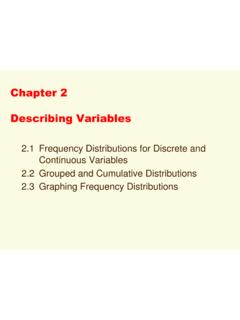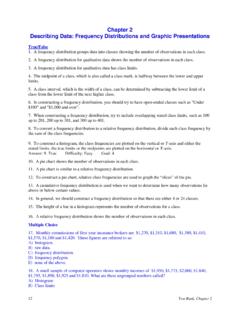Transcription of Chapter 3 Frequency Distributions - Kendall Hunt Publishing
1 Frequency Distributions Distributions as Tables Distributions as GraphsHistogram Frequency Polygon Eyeball-estimation The Shape of DistributionsDescribing Distributions The Normal distribution Eyeball-calibration Bar Graphs of Nominal and Ordinal Variables ConnectionsCumulative Review Computers Homework Tips Exercises for Chapter 3 Personal Trainer LECTLET 3A: Frequency Distributions as Tables LECTLET 3B: Frequency Distributions as Graphs LABS: Lab for Chapter 3 REViEwMASTER 3A: RESOuRCE 3A: Stem and Leaf Displays RESOuRCE 3X: Additional ExercisesChapter3333 Chapter 3: Frequency Distributions from Comprehending Behavioral Statistics by Russell Hurlburt 978-1-4652-0178-2 | 5th Edition | 2012 Copyright Property of Kendall Hunt Publishing 34 Chapter 3 Frequency DistributionsLearning ObjectivesQ How is a tabular Frequency distribution constructed?
2 2 What are class intervals and what role do they play in the development of grouped Frequency Distributions ?3 What are two graphical methods of representing interval/ratio data from grouped Frequency Distributions ?4 What steps are involved in eyeball-estimating Frequency Distributions ?5 How are these terms used to describe the shape of Distributions : unimodal, bimodal, symmetric, positively skewed, negatively skewed, asymptotic, normal?6 How is a bar graph similar to and different from a histogram? For what kind of data is each used?There are three main concepts in statistics: Frequency Distributions , the sampling distribution of the mean, and the test statistic. We focus in this Chapter on Frequency Distributions and how they are displayed: in tables (as ungrouped and grouped Frequency Distributions ) and in graphs (as histograms and Frequency polygons).
3 You will learn to eyeball-estimate Frequency Distributions and terminology for describing the shapes of Distributions : unimodal, bimodal, sym metric, positively and negatively skewed, asymptotic, and shows the grouped Frequency Distributions and Figure shows the his-tograms for the intellectual growth scores described in Chapter 1. [You may recall that Rosenthal and Jacobson (1968) led teachers to believe that second-graders identified as bloomers would show IQ spurts, but the other children were not expected to spurt. Ac tually, the bloomers were a random sample of second-graders no different, on aver-age, from the other children.] The grouped Frequency Distributions (Table ) and histo-grams (Figure ) show that the most frequently occurring IQ gain among the bloomers was between 10 and 20 IQ points, whereas the most frequently occurring IQ gain among the other children was between 0 and 10 IQ points.
4 It is also easy to see that there is con-siderable overlap between the bloomer and other children s intellectual GainBloomersOthers 61 70 1 0 51 60 0 0 41 50 0 0 31 40 0 1 21 30 2 2 11 20 614 1 10 118 9 0 2 9 19 10 0 31247*Based on a study by Rosenthal & Jacobson (1968)TaBle Grouped Frequency Distributions of intellectual growth (IQ gain) for Oak School bloomers and other children* Chapter 3: Frequency Distributions from Comprehending Behavioral Statistics by Russell Hurlburt 978-1-4652-0178-2 | 5th Edition | 2012 Copyright Property of Kendall Hunt Publishing Chapter 3 Frequency Distributions 3520 15 10 5 0 20 10 0 10 20 30 40 50 60 70 fIQ Gain of Bloomers20 15 10 5 0 20 10 0 10 20 30 40 50 60 70 fIQ Gain of OthersFIGURe Histograms of intellectual growth (IQ gain) for Oak School bloomers and other children (Based on Rosenthal & Jacobson, 1968)
5 The break in the X-axis shows that the Y-axis does not intersect at X = 0 as is could have made the same observations from inspecting the data in Chapter 1, but the Frequency Distributions that you will learn about in this Chapter make it easier to see the characteristics of a data that in Chapter 1 we pointed out the three major concepts in statistics: (1) what a distribution of a variable is and how to describe it, (2) what a sampling distribution of means is and how it is related to the distribution of a variable, and (3) what a test statistic is and how it is related to the sampling distribution of means. This Chapter (and also Chapters 4 and 5) focuses on the first concept, describing the Distributions of variables. Our first task is to convince our-selves that understanding Frequency Distributions will make it simpler for us to think about and communicate about , for example, that we are interested in the weights of male students in our statistics class.
6 There are 25 men in the class, and we measure each man s weight, with the results shown in Figure , where each man is represented by a 3: Frequency Distributions from Comprehending Behavioral Statistics by Russell Hurlburt 978-1-4652-0178-2 | 5th Edition | 2012 Copyright Property of Kendall Hunt Publishing 36 Chapter 3 Frequency Distributions 135 180 190 137 154 149 164 185 173 163 162 157 161 173 180 179 197 159 182 164 164 144 152 150 163 FIGURe Weights (lb) of male students as they sit in the classroomTaBle Enumeration of male students weights (lb)135180190137154149164185173163162157 161173180179197159182164164144152150163I n an enumerated list, you have to hunt for the largest or smallest suppose our friend Jack asks how heavy the male students in our class are.
7 We could simply list the data: The fi rst student weighs 135 pounds, the next student weighs 180 pounds, the third student weighs .. , and the last student weighs 163 pounds. This kind of listing is called an can be printed, as shown in Table An enumeration is a perfectly accurate answer to Jack s question about student weights, but it is probably an undesir-able answer both because it is too long (we give Jack more information than he wants) and because it does not highlight the important characteristics of the distribution (it does not, for example, make it easy to discover the largest or the smallest weight, or to see which weights occur most frequently).Statisticians make the answers to questions such as Jack s more informative by using Frequency Distributions in the form of tables or Lectlets and then 3A in the Personal Trainer for an audiovisual discussion of Sec tions and Distributions as TablesA tabular Frequency distribution is a table that lists the numerical values of a vari-able in a logical order along with Frequency of each value.
8 A variable, as we saw in Chapter 2, is that characteristic of interest that can take on dif ferent values for each enumeration Listing all points in a data settabular Frequency distribution An ordered listing of all values of a variable and their frequenciesPersonal TrainerLectletsChapter 3: Frequency Distributions from Comprehending Behavioral Statistics by Russell Hurlburt 978-1-4652-0178-2 | 5th Edition | 2012 Copyright Property of Kendall Hunt Publishing Distributions as Tables 37subject under consideration, and the Frequency (usually abbreviated f) is the num-ber of times a particular value of the variable occurs. Table shows the tabular Frequency distribution of male students weights. The value 163 occurs twice ( has Frequency 2 ), as do 173 and 180, and the value 164 is occurs three times ( has fre-quency 3 ).
9 All other frequencies for the weights listed in the table are 1. If a weight does not occur in the data of Table (for example, 142 or 181), then its Frequency is 0, and we omit it entirely in the Table Frequency that the sum of the frequencies (25 in our example) is shown at the bottom of the Frequency column and is always equal to the number of entries in the original data also that the Frequency distribution shows the values of the variable under con sideration (weight) in order; the convention is to put the largest value first. This presentation sim plifies our communication about the data. Now if Jack wants to know how heavy the men in our class are, we can immediately say, The lightest is 135 pounds, the second lightest is 137 pounds, the third lightest is 144 pounds.
10 , and the heaviest is 197 pounds. This is still a long and cumbersome answer, but the ordering makes it easier for Jack to gain some appreciation of how the weights stand in relation to each other. However, although this Frequency distribution is more informative than a simple enumeration of the individual weights, it has disadvantages: It still provides a long list of weights and their frequencies, and it is relatively difficult to identify weights with 0 grouped Frequency distribution (also called a Frequency distribution using class intervals ) is more compact and efficient. Successive weights are grouped together into class intervals and the frequencies are reported for the intervals, not for the individual weights, as shown in Table Note that the sum of the frequencies is still 25, the number of original use of class intervals (130 139 pounds, etc.)



















